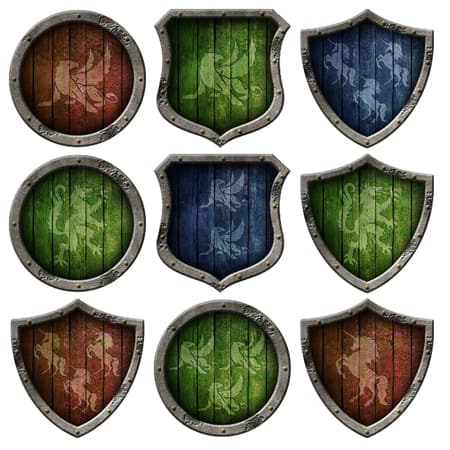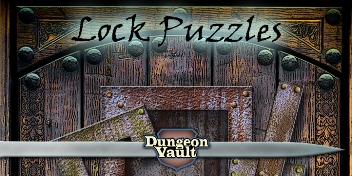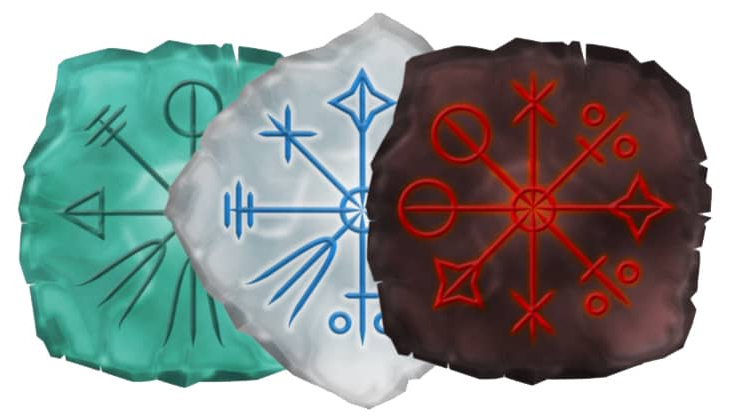Dwarves are arguably the coolest race in Dungeons & Dragons. Because let’s face it, nobody likes an elf. Kidding, but there is something about Dwarves and their rich culture that begs to be explored. And that’s why using puzzles that fit the Dwarven theme is perfect. Here’s why.
With puzzles, you can introduce many aspects of Dwarf society to your players in a fun and challenging way. And it is important to keep things challenging because just telling your players about Dwarven history in a long monologue will put any D&D player to sleep. In other words: Show, don’t tell.
With the use of a well-placed Dwarven puzzle, you can sneak in that lore and depth of story, while you’re putting your players’ problem-solving skills to the test. So let’s look at two puzzles we recommend
D&D Dwarven Puzzles: Runestones
No D&D campaign about Dwarfs is complete without stones and runes. And Runestone Puzzles have both. These stones are coveted by greedy Dwarven kings, or guarded by ancient Dragons.
In our game, solving a runestone puzzle gave players access to chambers built and locked by their ancestors so they could discover the history of their people and the weapons needed to hold back the denizens of the Underdark. But you can use Runestone Puzzles in any way you like.
We placed a Runestone locked room in each Dwarvenhold across the realm. So players had to first obtain the puzzle pieces and then solve the puzzle to gain access to the ancient Dwarven chambers. It worked perfectly but it is only one layer to our D&D dwarven puzzle campaign.
Runestone Puzzles is available in our webshop here.
D&D Dwarven Puzzles: The Game of Shields
For our second setup, we are using a Puzzle Pack called ‘the Game of Shields’. The puzzle comes with up to 81 heraldic shields for different factions. Players are presented with a combination of shields and – following the rules of the puzzle – need to figure out which combination of three leads to an alliance.

The rules are simple. Each shield has four aspects: Shape, color, symbol, and nr. of symbols. An alliance consists of three shields and the aspects need to be either:
- All the same.
- Or all different.

You can use this as a nice puzzle for any game. Just hang up these shields on the walls of a Dwarven mine, have players figure out what alliance can be made, and if they press those shields together a secret door hidden in the stone opens.
That’s the simple use of this puzzle but there’s a lot more to it. The Game of Shields is actually a complete system for using politics in your D&D game. We’ve tested it and it made using politics easier than I thought possible and more exciting. We especially liked how the system alternates between action and puzzle challenges.
YOU MAY ALSO LIKE:
The Game of Shields wasn’t designed as a Dwarven puzzle specifically but it fits the theme perfectly. We use the shields to represent clans instead of factions. Each dwarf in our game belongs to a clan and will only form alliances with other clans according to the rules of this puzzle.
That meant every dwarf players encounter belongs to a clan. And in order to get dwarfs to do anything players had to forge new alliances or break them. It also helped that all players in our campaign chose to be dwarfs of the same clan but they don’t have to be. Throughout the campaign, players managed to forge more alliances between various clans which prepared them for the final battle when evil forces from the Underdark rose from its depths.
The Game of Shields is available with our affiliate DungeonVault. Check out their fantastic collection of puzzles for D&D here.
Other Dwarven Puzzles for Dungeons & Dragons
Besides the dwarven puzzles already mentioned, there are some other puzzles that can work very well in a dwarven campaign with little to no adaptation. We like them because of the metal and stone theme that matches well with dwarven skills.
Lock Puzzles

Lock Puzzles can be placed onto doors, ancient tomes, chests, and anything else you wish to secure really. The system is brilliantly easy to use and set up.
The pack comes with nine basic puzzles that each have three pieces. If you wish to create an easy challenge, just place one basic puzzle on a door. But start combining these basic puzzles, and they become increasingly difficult to solve. For intstance, if you place all nine puzzles on the same door the average group might spend about half an hour solving the puzzle. Place a single basic puzzle on a door and they’ll solve it in seconds. Oh, did we mention there are over 500 ways to combine these nine basic puzzles? So don’t worry about replay value! Door puzzles comes in printable and VTT format.
Door Puzzles

Door Puzzles can be placed onto any door to instantly change it into a challenging puzzle. You simply pick a puzzle from the stack of 20 premade setups, hand your players the key pieces and sit back while they solve the challenge. Of all the puzzles we’ve seen this one is among the easiest for DMs to setup. Door puzzles comes in printable and VTT format.
The rules are simple. Each puzzle door has a grid and a number of pegs. Players must place the key pieces over the pegs to fill out the grid. Sounds simple enough right? But the hard part is that players get ALL the key pieces to choose from. And selecting the right combination requires a lot of logical reasoning.
We found door puzzles has a nice flow of discoveries. And players can work at solving it simultaneously. You can also view this puzzle from all sides which comes in very handy if your players are sitting around the table. Finally, you can create your own puzzles with this system. So you can create an infinite amount of puzzles if you wish.
All the mentioned puzzles and many more are in the Puzzle Bundle. So be sure to check it out!
Dark Ulf is the founder and editor of DNDpuzzles.com. When not writing for DNDpuzzles he travels the multiverse and destroys demons with a crossbow in one hand and a crossword in the other.
We hope this site inspires you to put more puzzles into your D&D games.



